#thammasat exchange
Explore tagged Tumblr posts
Text
Wissanu Krea-ngam, ehemaliger Vize-Premier der Thaksin- und Prayuth-Ära, wurde zum Vorsitzenden der Bangkok Post ernannt

BANGKOK: „Rechtsguru Wissanu Krea-ngam übernimmt das Ruder bei Bangkok Post“ Der ehemalige stellvertretende Premierminister, der dafür bekannt ist, die Regierungen von General Prayut Chan Ocha durch rechtliche Komplexitäten geführt zu haben, steht vor einer neuen Rolle. Er wurde diese Woche zum Vorsitzenden der Zeitung Bangkok Post ernannt. Der im Süden geborene Herr Wissanu ist Reportern und Medien in der Hauptstadt aus seiner Regierungszeit bekannt. Insbesondere für seine zentrale Rolle bei der Leitung der Arbeit von General Prayut Chan Ocha in seinen beiden Regierungen. Der Rechtsexperte war auch in Regierungen unter dem ehemaligen Ministerpräsidenten Thaksin Shinawatra tätig. Mit dem Amtsantritt der aktuellen Regierung im September 2023 zog er sich aus dem öffentlichen Leben zurück. Seine Ernennung wurde am Mittwoch vom Vorstand des Unternehmens bestätigt. Der 73-jährige Herr Wissanu gilt als einer der bedeutendsten juristischen Köpfe Thailands. Darüber hinaus ist er auch einer der erfahrensten Regierungsmitarbeiter des Landes. Kurz gesagt, er arbeitete hinter den Kulissen und überwachte aus erster Hand einige der bedeutendsten Verfahren des Königreichs seit 1991. Bangkok Post wurde unmittelbar nach dem Zweiten Weltkrieg im Jahr 1946 als englischsprachige Zeitung gegründet. Das Management leitete 1984 die Börsennotierung Die Bangkok Post wurde nach dem Zweiten Weltkrieg vom US-Militäroffizier Generalmajor Alexander McDonald und Herrn Prasit Lulitanon gegründet und ist eine führende englischsprachige Zeitung. Anschließend wurde die Bangkok Post später von einer deutschen Investmentgruppe übernommen. 1963 übernahm der zweite Herausgeber, Herr Henry Frederick, die Nachfolge von General McDonald. Danach wurde die Zeitung vom britischen Verlagsbaron Lord Thompson übernommen, der weltweit bis zu 150 Titel besaß. Im Gegenzug wurde es erweitert und modernisiert. Doch 1984 notierte die Bangkok Post unter der Leitung ihres Managementteams das Unternehmen an der Stock Exchange of Thailand (SET). Der in Songkhla geborene Wissanu Krea-ngam ist einer der brillantesten juristischen Köpfe Thailands und seit 33 Jahren ein äußerst erfahrener Insider in der Regierung Herr Wissanu stammt aus der südlichen Provinz Songkhla und ist thailändisch-chinesischer Abstammung in der vierten Generation. Er studierte an der Thammasat-Universität, bevor er als Rechtsanwalt in Thailand zugelassen wurde. Danach verließ er Thailand, um an der University of California in Berkeley zu studieren, wo er in den 1960er Jahren einen Master of Laws erwarb. Es folgte 1976 die Promotion zum Doktor der Rechtswissenschaften. Nach seiner Rückkehr nach Thailand wurde Herr Wissanu Dozent für Rechtswissenschaften an den Universitäten Ramkhamhaeng, Thammasat und Chulalongkorn. Danach wurde er 1986 zum Juraprofessor an der Chulalongkorn-Universität ernannt. Der damalige akademische Experte wandte sich 1991 als stellvertretender Generalsekretär des Kabinetts dem Staatsdienst zu. 1993 wurde er zum Generalsekretär befördert. In dieser Funktion war er an nicht weniger als vier neuen Regierungen beteiligt. Ex-Premier Thaksin Shinawatra holte Wissanu 2002 in sein Kabinett, wo er bis zum Staatsstreich im September 2006 als stellvertretender Premierminister fungierte Premierminister Thaksin Shinawatra erkannte die Fähigkeiten von Herrn Wissanu an und bat ihn 2002, Minister zu werden. Anschließend wurde er bis zum Staatsstreich im September 2006 zum stellvertretenden Premierminister ernannt. Danach übernahm Herr Wissanu Krea-ngam eine unabhängige Direktorenstelle bei Bangkok Post Plc. Es dauerte vier Jahre, bis er erneut in die Regierung berufen wurde. Diesmal stand es unter der Regierung des Nationalen Rates für Frieden und Ordnung (NCPO) von General Prayuth Chan-o-cha. Herr Wissanu übernahm die Rolle im August 2014. In der ersten Regierung von General Prayuth unter der Junta war Herr Wissanu der gesetzliche Vormund der Regierung, die über beispiellose Befugnisse verfügte. Danach war der stellvertretende Premierminister aktiv an der Ausarbeitung der Verfassung von 2017 und der Rückkehr Thailands zur Demokratie im Jahr 2019 beteiligt. Wissanu Krea-ngams Rolle in den Ministerien von General Prayuth Chan Ocha war von besonderer Bedeutung, da er die Regierung durch juristische Minenfelder führte In seiner Rolle als stellvertretender Premierminister der zweiten Regierung von General Prayuth leitete Herr Wissanu das Justizministerium und die damit verbundenen Behörden. Er war auch an Sofortmaßnahmen zur Bewältigung der Pandemiekrise beteiligt. Die Aufgabe des klugen Juristen bestand darin, zu verhindern, dass General Prayuth und seine Regierung in rechtliche Fallstricke geraten. Er war außerordentlich erfolgreich. Tatsächlich trug es dazu bei, der Zeit eine Aura der Stabilität zu verleihen. Schließlich war Herr Wissanu auch bis zur Machtübergabe an die neue Pheu-Thai-Regierung im September 2023 eine Schlüsselfigur. Insbesondere seine Rolle bei der Erleichterung der Rückkehr seines ehemaligen Chefs Thaksin Shinawatra am 22. August 2023. Ein Autor politischer Belletristik, der auf seiner Zeit an der Macht basiert Während seiner Zeit an der Macht war der Rechtsberater der Prayuth-Regierung für seinen Witz und sein Charisma bekannt. Er informierte Reporter oft und ging sogar so weit, rechtliche Angelegenheiten in vereinfachten Worten zu erklären. Am Weihnachtstag 2023 kehrte der ehemalige stellvertretende Premierminister ins Regierungsgebäude zurück. Er war dort, um für sein Belletristikbuch „No. 1 Phitsanulok Road" zu werben. Die Ereignisse des Buches wurden größtenteils als Darstellungen der Erfahrungen von Herrn Wissanu in der zweiten Regierung von General Prayuth angesehen. Herr Wissanu war in einem unbeschwerten und „lustigen“ Stil geschrieben und bestand darauf, dass es sich nicht um einen Dokumentarfilm handele. Herr Wissanu sprach mit Reportern in seinem gewohnt rätselhaften Stil und beschrieb sein Buch als Band Zwei. Er sagte, dass Band Eins nicht zum Verkauf stehe, obwohl er sicherlich mehr Publizität erhalten habe. Quelle: Thai Examiner (dir) Read the full article
0 notes
Link
It is a time of rebellion. Thousands of Thais are marching in the streets in defiance of the establishment, which has enlisted every available apparatus to quell young protesters challenging an idea of Thainess defined by the trilogy of the nation, religion and monarchy. Thai Buddhist institutions have good reason to be enrolled in the fight. Yet its members are demonstrating together with angry lay compatriots. The activism of young monks is impressive. Contrary to the conventional view that monks are detached from worldly sufferance, these progressive monks are aware of the Sangha’s role in upholding the status quo and injustice. They want to reinterpret the role of the Sangha anew to serve the people and be the voice of public morality.
Since its conception in 1902, the Thai Sangha, the official order of Thai monks, has been a faithful ally of the Thai state. In exchange for special recognition and patronage, it loyally supplies the state with legitimacy and endorsement. Most notably during the Cold War, when military governments were waging war on communism, the government of Field Marshall Sarit Thanarat asked the Thai Sangha to preach not about sufficiency but more materialistic sermons as a capitalistic antidote to blossoming communism. Sarit also sent convoys of monks into rural areas to mark the presence of the Thai state and convert hill tribes and rural farmers. Amulets were specially made and given to police and soldiers fighting at the front line.
Perhaps the most famous incident was Phra Kittivuttho’s remark that killing a communist was not a sin, interpreted as an endorsement of the right-wing militia’s massacre of left-leaning university students at Thammasat University on 6 October 1976. But Kittivuttho may not be an anomaly, as onlookers often label him. Thai Buddhism has always endorsed the state’s violence when that violence is invoked for “righteous” objectives defined by the government. In the Thai-Lao border conflict of Bann Rom Klao, Phra Panyananda Bhikhu expressed his support for the soldiers fighting for the nation. After the 2010 red shirt crackdown, Phra Maha Wutthichai Wachirametee tweeted that killing time was more sinful than killing a man.
What happens when the Sangha fails to show its support? When Abbot Phra Thep Moli objected to His Majesty’s decision to join the First World War in an anti-war sermon and condemnation of the soldier profession, King Vajiravuth demoted him.
On 30 October 2020, the Sangha Council, the governing body of the Thai Sangha, issued a resolution forbidding the use of temples as venues for political expression. The Sangha Council also reminded monks that monks and novices are not allowed to participate in political protest. Nor can they write openly about politics. These restrictions are based on the pretext that the spiritual realm shall remain separate and above the mundane realm, to maintain the flawless image of the holy men.
Yet other resolutions contradict this image of neutrality. Another commanded that monks preach sermons to raise awareness and love of the nation, religion and king. Many units of the Border Patrol Police, brought into Bangkok as riot-control forces, are staying in temples. Moreover, the government is encouraging civil servants and ordinary Thais to join religious services every Saturday to pay homage to the late King Bhumibol and wish for the betterment and unity of the nation.
In sum, the Thai Sangha is supplying the state not only with spiritual endorsement but also logistical support. It is not and has never remained neutral in political conflict.
43 notes
·
View notes
Text
Top Ten Richest Lawyers
So, who are they? Here is a fast look at the richest lawyers in the world, ranked from the lowest net value to the greatest. Please be aware that the individuals on this list are practicing lawyers or judges. There are loads of other "lawyers" with a substantially higher net value, but they just possess a law degree and no more use it.
Vernon E. Jordan Jr.: $12 million
Born in 1935, Jordan has enjoyed a long law career that started after his graduation from Howard University. (In addition, he holds more than 70 honorary degrees from various colleges and universities.) He is currently the senior council, focusing on general council, business, and global law, at Akin, Gump, Strauss, Hauer, and Feld LLP. His early career focused primarily on civil rights, while he later served as an advisor to President Clinton. The majority of his fortune was earned by representing huge corporations, including Xerox and American Express, in addition to spending time as Wall Street banker.
Judy Sheindlin: between $150 million and $250 million
Best known for being a no-nonsense TV judge, Judge Judy earns $47 million a year. A 1965 graduate of New York Law School, Judge Sheindlin was originally a corporate lawyer, though she immediately grew tired of it and decide to become a household court prosecutor. Back in 1982, she was appointed as a criminal court judge, where she gained a reputation as a "tough" judge and presided over more than 20,000 cases. This, together with several novels she wrote, caught the attention of TV executives and eventually led to her TV series. Additionally, she's the author of seven novels and has served as legal counsel on various TV shows.
Wichai Thongtang: $1.1 billion
Thought of by many in the industry to become "one of the top names in the profession from around the planet," Wichai Thongtang is a strong lawyer in Thailand. After graduating from Thammasat University in 1970, he moved to corporate law, by which he represented a range of leading Thai executives and corporations and took the opportunity to learn about the stock exchange and investing. Besides his law career, Thongtang is the Chairman of Cable Thai Holding PLC and owns 15 percent of Dusit Medical, a Bangkok healthcare company.
Thomas Mesereau: $25 million
Additionally a criminal defense lawyer (Are you noticing a trend?) , Thomas Mesereau graduated from Harvard University and The University of California's Hastings College of Law and has been appointed "Trial Lawyer of the Year for 2015" by the National Trial Lawyers. (He has won lots of other awards such as "Criminal Defense Lawyer of the Year. ") He is known for carrying high stakes instances with hopeless odds and getting extraordinary results. He was Michael Jackson's lawyer when he had been acquitted of 14 child molestation charges and has won an unprecedented three national criminal jury trials in a row. While his hourly rate is so large it's not published, he also does pro bono work through the Mesereau Free Legal Clinic.
Willie E. Gary: $100 million
Nicknamed "The Giant Killer," Willie Gary has taken on several of the nation's most important corporations, including Anheuser-Busch and Disney. He's won a number of the largest settlements and jury awards in the U.S., including several cases valued at more than $30 billion. A graduate of Shaw University, he's now the managing partner at Gary, Williams, Parenti, Watson, and Gary, P.L.L.C., works as a motivational speaker, and has appeared as a legal analyst on "The Early Show. "
1 note
·
View note
Text
Top Lawyers In Usa
So, who are they? Here is a fast look at the richest attorneys in the entire world, ranked from the lowest net value to the highest. Please be aware that the people on this list are practicing lawyers or judges. There are loads of additional "lawyers" using a substantially higher net value, but they just have a law degree and no more use it.
Alan Dershowitz: $25 million
After graduating from Harvard Law School in 1962, Alan Dershowitz went to work. By 1964he had become a member of the Harvard Law School school and in 1967, he had been made a full professor. (He retired in 2013.) While teaching courses, he was also making a name for himself in the criminal law area. Thanks to his reputation as the "top lawyer of last resort," he has a bevy of high-profile clients, such as Mike Tyson, Jim Baker, Leona Helmsley, O.J. Simpson, and Jeffrey Epstein. In addition, he has composed over a dozen novels. Everything collectively helped him collect his fortune
Jane Wanjiru Michuki: $60 million
Educated at the Kenya School of Law and Warwick University, Jane Wanjiru Michuki is currently a managing partner at Kimani & Michuki Advocate, a corporate law firm in Nairobi, Kenya that represents several of the largest companies in Kenya, for example Equity Group Holdings Limited. In addition to her law career, she's the largest female stockholder on the Nairobi Stock Exchange, which is where a good piece of her net worth stems from.
Judge Joe Brown: $30 million
Best known for his day court show which ran for 15 years, Judge Joe Brown received his law degree from UCLA. After serving as the initial African American prosecutor at Memphis, TN, he opened his own clinic before working as a criminal court judge in Shelby County, TN. While presiding over James Earl Ray's appeal for the assassination of Martin Luther King, Jr., he caught the eye of TV manufacturers. The majority of his wealth was gained via the show. In 2014, he ran for district attorney general in Shelby County, but lost to the incumbent.
Wichai Thongtang: $1.1 billion
Considered by many in the industry to become "one of the top names in the profession from around the globe," Wichai Thongtang is a strong lawyer in Thailand. After graduating from Thammasat University in 1970he moved into corporate law, by which he represented a number of top Thai executives and businesses and took the opportunity to learn about the stock market and investing. Besides his law profession, Thongtang is the Chairman of Cable Thai Holding PLC and owns 15 percent of Dusit Medical, a Bangkok healthcare company.
1 note
·
View note
Photo

Space of Political Expression, “The Everyday assembly”
To consider the subject of people's rights in true perspective, the project is started with the human architectural scale. I observed how students were playing an important role in the crucial political debates and protests in many countries. For example, in the Athens school of architecture, the Thammasat Massacre, and the Tiananmen Square student protest, and many other movements. Even though some of these movements are quite violent, they bring about some changes no matter large or small.
From my research about democratic space, it stated, "There may not be one right way to design a democratic public space, but by learning and experimenting, testing assumptions, and responding, and by putting the citizens or users in the center of the process, we are performing democracy."
Also similarly from another reading, the idea of "setting diversity as the goal, and by understanding context, culture, and users’ needs are being emphasized.” These statement is proving that the free people’s space should start with the people centre design.
After interviewing some of my friends to understand how much people in my generation participate in political talk, I could categorise them into two groups, the active and the passive participants. To make people talk about politics, there is a need for a trigger that would make them relate more to the topic and engage in the conversation; therefore, the idea of sensory experience and the immersive theatre play is being use as the base of the design.
The site that I am choosing for the design is at the faculty of architecture, Chulalongkorn University.
One of the reasons why this location is chosen is because there is usually an event or a ritual every year that would encourage people to participate and transform the space for other use. The design would be possible to be active in this space.

Fig 3.1. Architecture building original plan
The cafeteria space is specifically picked also because it is a space that is already active for interactions. People normally participate in a group talking.
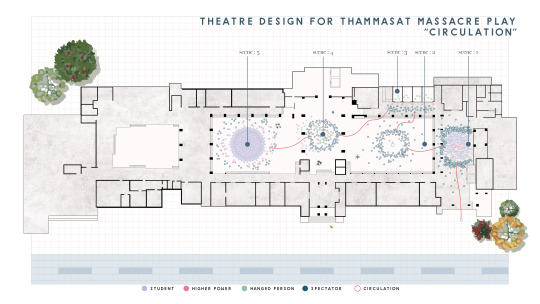
Fig 3.2. Circulation Plan of the Thammasat Massacre Play Design
The overall design is started with the sequence of the Thammasat Massacre event because it is one of the most significant political events in Thailand which people still recall. The sequence of the events is being translated onto the circulation plan on how people should act in the space, and how they are divided into each of the categories. By allowing people to act on the reenactment, it would also make them understand the situation more, like how the police are investigating the cases.
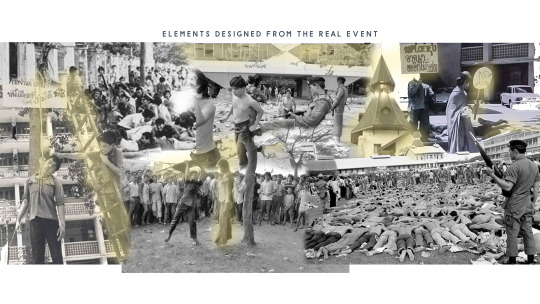
Fig 3.3. Inspiration of the Furniture Design
From that, the specific elements from each scene of the Thammasat Massacre are being use as inspiration for the furniture design for space.

Fig 3.4. Furniture Design
These pieces of furniture are modular and movable, so it could be used in the transformation of the space from the theatre space to the cafeteria, then the assembly space. The pieces are the Thammasat dome which is transforming into a prison, the assembling tables which is inspired from the building window, the Talipot fan which is used for poster exhibition, the ladder, the fences, the 14th Oct chair which is being during the Thammasat Massacre to hit the students with, the curtain which symbolized the hanged person, and the shoes which are enlarged to be the cemetery.
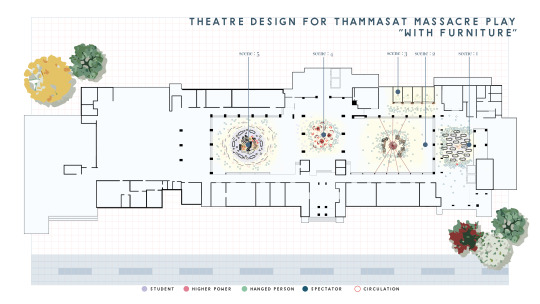
Fig 3.5. The Thammasat Massacre Play Design “with Furniture”
Afterwards, the design of the furniture layout is based on the base circulation of the play as you can see that it is separated into five scenes in sequence from right to left.

Fig 3.6. The Cafeteria Space Design
These spaces after being used as a part of the immersive theater play, the furniture are movable to transform into cafeteria space. The cafeteria spaces are for eating, reading, club space, group study, and a free space for a reassemble.
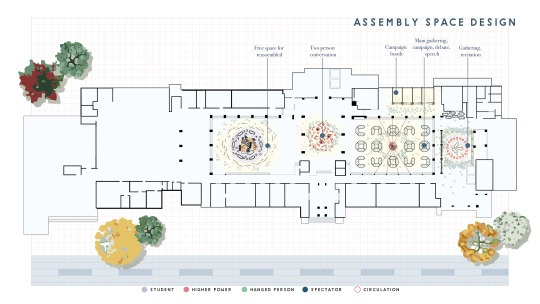
Fig 3.7. The Assembly Space Design
Also, the space is transformable into assembly space for a political gathering, talk, debate, speech, or campaign space based on any issue referring back to the quote that I stated earlier that the space of freedom does not fit into one.

Fig 3.8. SCENE I
For background information, the Thammasat massacre happened because the Thai press reported on a play staged by student protesters, on 6 October 1976, which allegedly featured the mock hanging of then Crown Prince Vajiralongkorn causing the attack by Thai state forces on student protesters on the campus of Thammasat University. But prior to the massacre, four to five thousand students from various universities had demonstrated for more than a week against the return of former military dictator Thanom Kittikachorn to Thailand from Singapore, so it is said that students were blamed unjustly by the press.
During SCENE 1, the monk is trying to receive alms from the dead students on the 6th October, while one student walks across the death to ask for permission to go to exam.
For scene one of the theatre design, I put the cemetery to symbolize the death students that were on the ground, and put the TalaPad fan to symbolize the Monk, and make the layout hard for the students to struggle to go past the area.
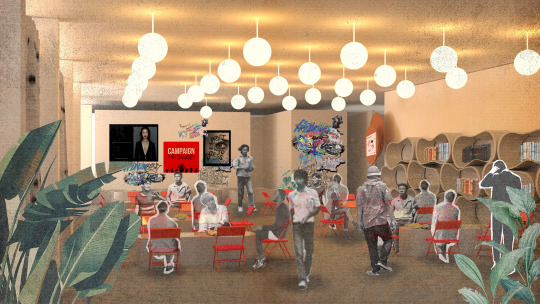
Fig 3.9. SCENE I, Cafeteria
For cafeteria space, this is an eating space which can be used for reading and club space.
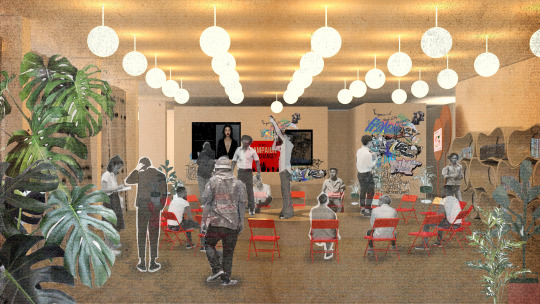
Fig 3.10. SCENE I, Assembly
For assembly purpose, the space is used for gathering, recitation, and the exchange of ideas in large groups inspired from the circular plan

Fig 3.11. SCENE I, Plan
This is an architectural diagram of the space.

Fig 3.12. SCENE II
For SCENE 2, the main actor was hung down from the tree with the soldier to symbolize the the hanging of the Electric Authority in going against the monk.
So in the center, I designed the curtain installation that would symbolize the hung person where the furniture around symbolizing the people watching the event.
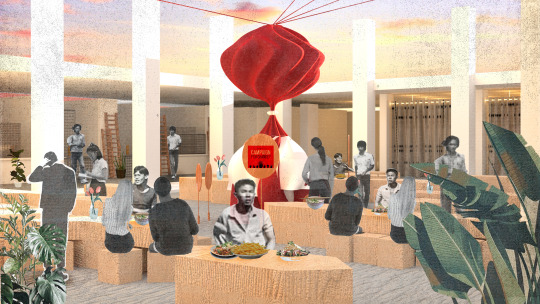
Fig 3.13. SCENE II, Cafeteria
For the cafeteria, it is transformable into the main cafeteria space and the table are movable up to the students' needs.
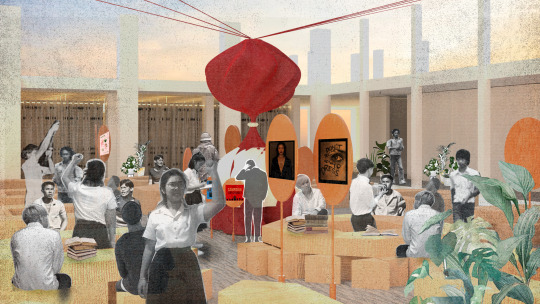
Fig 3.14. SCENE II, Assembly
The space is also used for campaigning purposes, debate speech, or a club space.
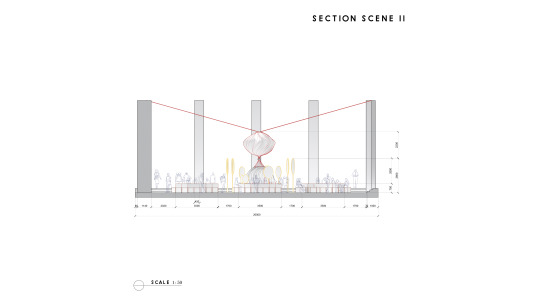
Fig 3.15. SCENE II, Section

Fig 3.16. SCENE II, Axon

Fig 3.17. SCENE III
For SCENE 3, the police deceive all the main actors and put them in jail without warning.
The fences that used to protect the shooter of the Thammasat Massacre were used as the design of the movable fences of the prison design in the theater play, and the ladder is symbolizing the higher power that are watching over the innocent students.
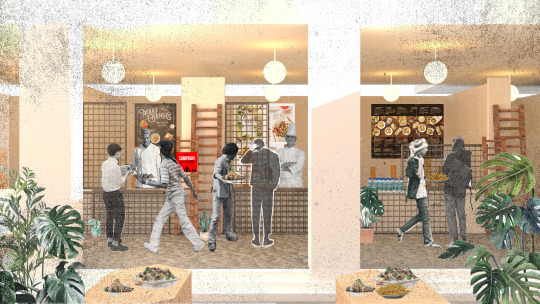
Fig 3.18. SCENE III, Cafeteria
For the cafeteria, the space is used as a food stall.

Fig 3.19. SCENE III, Assembly
The space is also transformable into the campaign booth area.

Fig 3.20. SCENE III, Section and Plan

Fig 3.21. SCENE IV
For SCENE 4, the higher power were taking the students outside to hang them on the tree and start hurting them while most student got arrested.
The chairs that were used for hitting the death students were laid all over the place and a curtain symbolised the innocent death.
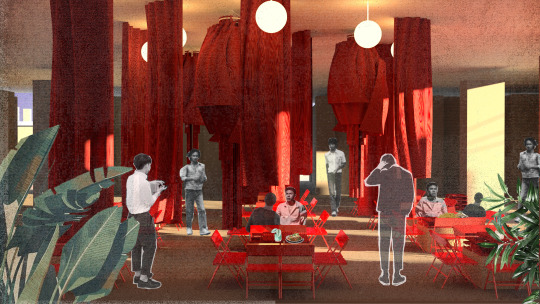
Fig 3.22. SCENE IV, Cafeteria
The space can also be used as an eating area and for studying in groups.
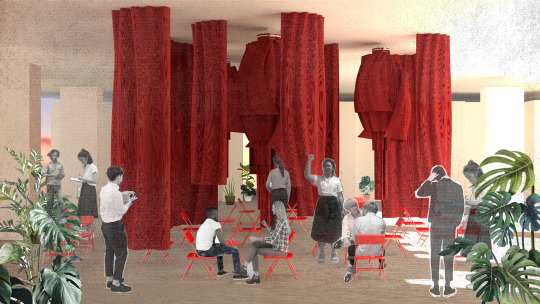
Fig 3.23. SCENE IV, Assembly
The assembly is for two person conversation which is influenced by the church confession box design where people are allowed to talk about anything without being judged on.

Fig 3.24. SCENE IV, Section and Plan
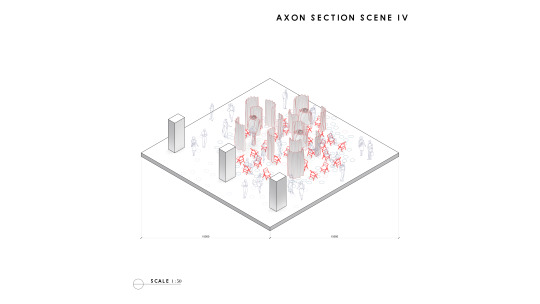
Fig 3.25. SCENE V, AXON

Fig 3.26. SCENE V
For SCENE 5, the uprising of the protest within the space were happening. Then the police forces were mass shooting from outside the fences of the University. Lastly, the space is lockdown, and everyone were laying on the ground with the soldier around them.
This is the last scene, and it is the most significant one because it is a space where the students were forced to surrender to the higher power, so this space is designed as a pile of wreck objects. The fences are symbolizing the higher power that is being protected behind these fences. This space is being planned for no alteration because it symbolises the ruins of democracy.
To summarise the design, these section of axon drawing of scene one to show clearly how the space is being transformed and reorganise for each of the purposes.
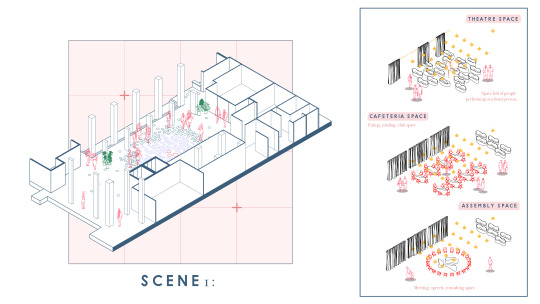
For scene I, I emphasised on the table and the chair reorganisation of the space.
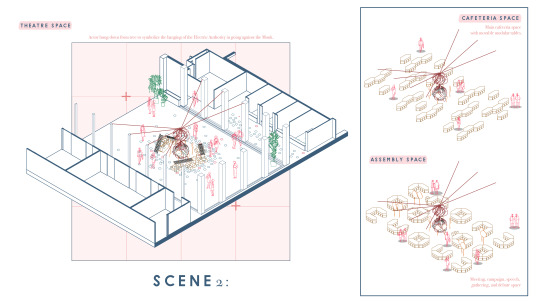
For scene two, the space is being emphasized on the rearrangement of the table plan to achieve the goal of each space.

Scene three is emphasized on the reorientation of the fences.
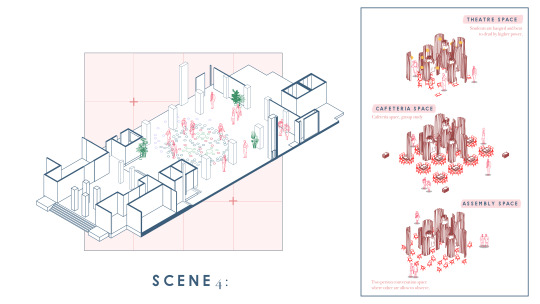
Scene four is emphasised on the reorganization after 14 October chair.
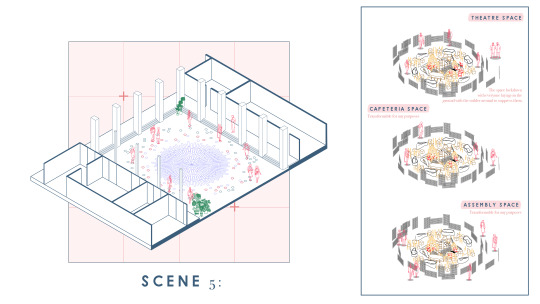
The last scene is where I stated that it would stay the same throughout and can be adaptable and transformable according to the students' needs.
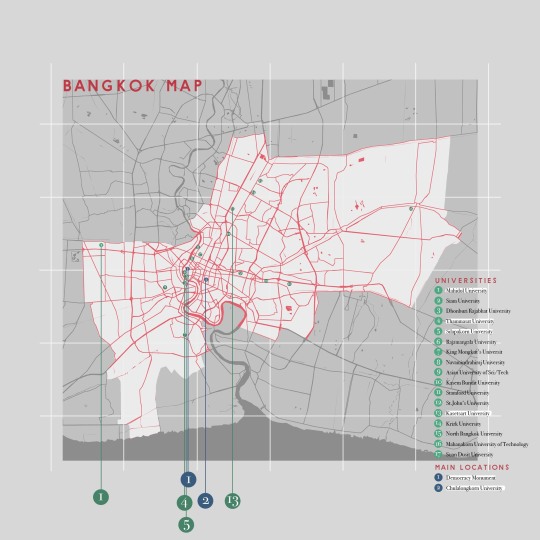
For the urban scale, I mapped out the significant universities relating to the government that this design could be placed to make a statement.
5 notes
·
View notes
Text
Top 10 Richest Lawyers In The World
So, who are they? Here is a quick look at the richest lawyers in the entire world, ranked from the lowest net worth to the greatest. Please note that the people on this list are all practicing attorneys or judges. There are plenty of additional "attorneys " with a substantially higher net worth, but they simply possess a law degree and no longer use it.
Judge Joe Brown: $30 million
Best known for his day court show which ran for 15 decades, Judge Joe Brown received his law degree from UCLA. After working as the first African American prosecutor at Memphis, TN, he opened his own clinic before working as a criminal court judge in Shelby County, TN. While presiding over James Earl Ray's appeal for the assassination of Martin Luther King, Jr., he grabbed the eye of TV manufacturers. The majority of his wealth had been obtained via the show. In 2014, he ran for district attorney general in Shelby County, but lost to the incumbent.
Alan Dershowitz: $25 million
After graduating from Harvard Law School in 1962, Alan Dershowitz went right to work. By 1964he had become a part of the Harvard Law School school and in 1967he had been made a full professor. (He retired in 2013.) While teaching classes, he was also making a name for himself in the criminal law field. As a result of his standing as the "top lawyer of last resort," he's a bevy of high-profile customers, such as Mike Tyson, Jim Baker, Leona Helmsley, O.J. Simpson, and Jeffrey Epstein. In addition, he's written over a dozen novels. Everything collectively helped him amass his fortune
Wichai Thongtang: $1.1 billion
Thought of by many in the sector to be "one of the best names in the profession from around the globe," Wichai Thongtang is a powerful lawyer in Thailand. After graduating from Thammasat University in 1970he moved into corporate law, by which he represented a range of leading Thai executives and corporations and took the chance to learn about the stock market and investing. Besides his law career, Thongtang is the Chairman of Cable Thai Holding PLC and owns 15 percent of Dusit Medical, a Bangkok healthcare company.
Jane Wanjiru Michuki: $60 million
Educated at the Kenya School of Law and Warwick University, Jane Wanjiru Michuki is a managing partner at Kimani & Michuki Advocate, a corporate law firm in Nairobi, Kenya that represents several of the biggest companies in Kenya, such as Equity Group Holdings Limited. In addition to her law career, she's the largest female stockholder on the Nairobi Stock Exchange, which is where a fantastic bit of her net worth comes from.
Willie E. Gary: $100 million
Nicknamed "The Giant Killer," Willie Gary has taken on a number of the nation's biggest corporations, including Anheuser-Busch and Disney. He has won a number of the largest settlements and jury awards at the U.S., including several cases valued at more than $30 billion. A graduate of Shaw University, he is now the managing partner at Gary, Williams, Parenti, Watson, and Gary, P.L.L.C., functions as a motivational speaker, and has emerged as a legal analyst on "The Early Show. "
0 notes
Text
Top Lawyers In Usa
So, who are they? Here's a quick look at the wealthiest lawyers in the entire world, ranked from the lowest net worth to the greatest. Please note that the people on this list are practicing lawyers or judges. There are plenty of additional "attorneys " with a considerably higher net worth, but they just possess a law degree and no longer use it.
Roy Black: $100 million
Yet another civil and criminal defense attorney, Roy Black, a graduate from the University of Miami, is the senior partner at Black, Srebnick, Kornspan, & Stumpf. For more than 40 decades, he's represented high profile customers, such as William Kennedy Smith (acquitted on rape charges), Albertson's, Inc., and Helio Castroneves. Known by most in the industry for having "the best national standing in Florida," he also acts as a legal analyst on "The Now Show" and "Good Morning America" and instructs advanced criminal signs in the University of Miami.
Wichai Thongtang: $1.1 billion
Thought of by many in the sector to become "one of the best titles in the profession from around the planet," Wichai Thongtang is a powerful lawyer in Thailand. After graduating from Thammasat University in 1970, he went into corporate law, by which he represented a range of leading Thai executives and corporations and took the opportunity to learn about the stock exchange and investing. In addition to his law profession, Thongtang is the Chairman of Cable Thai Holding PLC and owns 15% of Dusit Medical, a Bangkok healthcare firm.
Jane Wanjiru Michuki: $60 million
Educated at the Kenya School of Law and Warwick University, Jane Wanjiru Michuki is a managing partner at Kimani & Michuki Advocate, a corporate law firm in Nairobi, Kenya that represents several of the largest companies in Kenya, such as Equity Group Holdings Limited. In addition to her law career, she is the biggest female stockholder on the Nairobi Stock Exchange, which is where a fantastic bit of her net worth comes from.
Willie E. Gary: $100 million
Nicknamed "The Giant Killer," Willie Gary has taken on a number of the nation's biggest corporations, including Anheuser-Busch and Disney. He has won some of the biggest settlements and jury awards at the U.S., including many cases valued at more than $30 billion. A graduate of Shaw University, he is now the managing director at Gary, Williams, Parenti, Watson, and Gary, P.L.L.C., works as a motivational speaker, and has emerged as a legal analyst on "The Early Show. "
0 notes
Text
Events 10.14
1066 – The Norman conquest of England begins with the Battle of Hastings. 1322 – Robert the Bruce of Scotland defeats King Edward II of England at the Battle of Old Byland, forcing Edward to accept Scotland's independence. 1586 – Mary, Queen of Scots, goes on trial for conspiracy against Queen Elizabeth I of England. 1656 – The General Court of the Massachusetts Bay Colony enacts the first punitive legislation against the Religious Society of Friends. 1758 – Seven Years' War: Frederick the Great suffers a rare defeat at the Battle of Hochkirch. 1773 – The first recorded ministry of education, the Commission of National Education, is formed in the Polish–Lithuanian Commonwealth. 1805 – War of the Third Coalition: A French corps defeats an Austrian attempt to escape encirclement at Ulm. 1806 – War of the Fourth Coalition: Napoleon decisively defeats Prussia at the Battle of Jena–Auerstedt. 1808 – The Republic of Ragusa is annexed by France. 1843 – Irish nationalist Daniel O'Connell is arrested by the British on charges of criminal conspiracy. 1863 – American Civil War: Confederate troops under the command of A. P. Hill fail to drive the Union Army completely out of Virginia. 1884 – George Eastman receives a U.S. Government patent on his new paper-strip photographic film. 1888 – Louis Le Prince films the first motion picture, Roundhay Garden Scene. 1898 – The steam ship SS Mohegan sinks near the Lizard peninsula, Cornwall, killing 106. 1908 – The Chicago Cubs defeat the Detroit Tigers, 2–0, clinching the 1908 World Series; this would be their last until winning the 2016 World Series. 1910 – English aviator Claude Grahame-White lands his aircraft on Executive Avenue near the White House in Washington, D.C. 1912 – Former president Theodore Roosevelt is shot and mildly wounded by John Flammang Schrank. With the fresh wound in his chest, and the bullet still within it, Roosevelt delivers his scheduled speech. 1913 – Senghenydd colliery disaster, the United Kingdom's worst coal mining accident, claims the lives of 439 miners. 1915 – World War I: Bulgaria joins the Central Powers. 1920 – Finland and Soviet Russia sign the Treaty of Tartu, exchanging some territories. 1933 – Germany withdraws from the League of Nations and World Disarmament Conference. 1939 – World War II: The German submarine U-47 sinks the British battleship HMS Royal Oak within her harbour at Scapa Flow, Scotland. 1940 – World War II: The Balham underground station disaster kills sixty-six people during the London Blitz. 1943 – World War II: Prisoners at Sobibor extermination camp covertly assassinate most of the on-duty SS officers and then stage a mass breakout. 1943 – World War II: The American Eighth Air Force loses 60 of 291 B-17 Flying Fortress during the Second Raid on Schweinfurt. 1943 – World War II: The Second Philippine Republic, a puppet state of Japan, is inaugurated with José P. Laurel as its president. 1947 – Chuck Yeager becomes the first person to exceed the speed of sound. 1949 – The Smith Act trials of Communist Party leaders in the United States convicts eleven defendants of conspiring to advocate the violent overthrow of the federal government. 1952 – Korean War: The Battle of Triangle Hill is the biggest and bloodiest battle of 1952. 1956 – Dr. B. R. Ambedkar, leader of India's Untouchable caste, converts to Buddhism along with 385,000 of his followers (see Neo-Buddhism). 1957 – The 23rd Canadian Parliament becomes the only one to be personally opened by the Queen of Canada. 1957 – At least 81 people are killed in the most devastating flood in the history of the Spanish city of Valencia. 1962 – The Cuban Missile Crisis begins when an American reconnaissance aircraft takes photographs of Soviet ballistic missiles being installed in Cuba. 1964 – Martin Luther King Jr. receives the Nobel Peace Prize for combating racial inequality through nonviolence. 1964 – The Soviet Presidium and the Communist Party Central Committee each vote to accept Nikita Khrushchev's "voluntary" request to retire from his offices. 1966 – The city of Montreal begins the operation of its underground Montreal Metro rapid transit system. 1968 – The first live TV broadcast by American astronauts in orbit is performed by the Apollo 7 crew. 1968 – The 6.5 Mw Meckering earthquake shakes the southwest portion of Western Australia with a maximum Mercalli intensity of IX (Violent), causing $2.2 million in damage and leaving 20–28 people injured. 1968 – Jim Hines becomes the first man ever to break the so-called "ten-second barrier" in the 100-meter sprint with a time of 9.95 seconds. 1973 – In the Thammasat student uprising, over 100,000 people protest in Thailand against the military government. Seventy-seven are killed and 857 are injured by soldiers. 1975 – An RAF Avro Vulcan bomber explodes and crashes over Żabbar, Malta after an aborted landing, killing five crew members and one person on the ground. 1979 – The first National March on Washington for Lesbian and Gay Rights draws approximately 100,000 people. 1981 – Vice President Hosni Mubarak is elected as the President of Egypt, one week after the assassination of Anwar Sadat. 1982 – U.S. President Ronald Reagan proclaims a War on Drugs. 1991 – Burmese opposition leader Aung San Suu Kyi is awarded the Nobel Peace Prize. 1994 – Yasser Arafat, Yitzhak Rabin and Shimon Peres receive the Nobel Peace Prize for their role in the establishment of the Oslo Accords and the framing of future Palestinian self government. 1998 – Eric Rudolph is charged with six bombings, including the 1996 Centennial Olympic Park bombing in Atlanta, Georgia. 2003 – The Steve Bartman Incident takes place at Wrigley Field in Chicago, Illinois. 2004 – MK Airlines Flight 1602 crashes during takeoff from Halifax Stanfield International Airport, killing all seven people on board. 2004 – Pinnacle Airlines Flight 3701 crashes in Jefferson City, Missouri. The two pilots (the aircraft's only occupants) are killed. 2012 – Felix Baumgartner successfully jumps to Earth from a balloon in the stratosphere. 2014 – A snowstorm and avalanche in the Nepalese Himalayas triggered by the remnants of Cyclone Hudhud kills 43 people. 2014 – The Serbia vs. Albania UEFA qualifying match is canceled after 42 minutes due to several incidents on and off the pitch. Albania is eventually awarded a win. 2015 – A suicide bomb attack in Pakistan kills at least seven people and injures 13 others. 2017 – A massive truck bombing in Somalia kills 358 people and injures more than 400 others.
0 notes
Photo

Space of Political Expression, “The Everyday assembly”
To consider the subject of people's rights in true perspective, the project is started with the human architectural scale. I observed how students were playing an important role in the crucial political debates and protests in many countries. For example, in the Athens school of architecture, the Thammasat Massacre, and the Tiananmen Square student protest, and many other movements. Even though some of these movements are quite violent, they bring about some changes no matter large or small.
From my research about democratic space, it stated, "There may not be one right way to design a democratic public space, but by learning and experimenting, testing assumptions, and responding, and by putting the citizens or users in the center of the process, we are performing democracy."
Also similarly from another reading, the idea of "setting diversity as the goal, and by understanding context, culture, and users’ needs are being emphasized.” These statement is proving that the free people’s space should start with the people centre design.
After interviewing some of my friends to understand how much people in my generation participate in political talk, I could categorise them into two groups, the active and the passive participants. To make people talk about politics, there is a need for a trigger that would make them relate more to the topic and engage in the conversation; therefore, the idea of sensory experience and the immersive theatre play is being use as the base of the design.
The site that I am choosing for the design is at the faculty of architecture, Chulalongkorn University.
One of the reasons why this location is chosen is because there is usually an event or a ritual every year that would encourage people to participate and transform the space for other use. The design would be possible to be active in this space.

Fig 3.1. Architecture building original plan
The cafeteria space is specifically picked also because it is a space that is already active for interactions. People normally participate in a group talking.
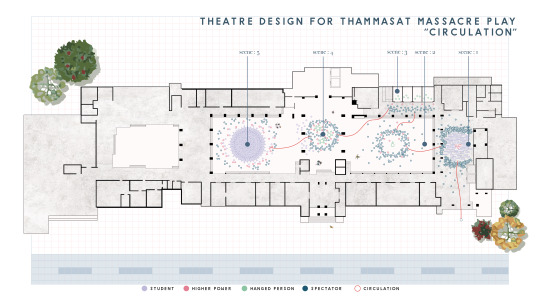
Fig 3.2. Circulation Plan of the Thammasat Massacre Play Design
The overall design is started with the sequence of the Thammasat Massacre event because it is one of the most significant political events in Thailand which people still recall. The sequence of the events is being translated onto the circulation plan on how people should act in the space, and how they are divided into each of the categories. By allowing people to act on the reenactment, it would also make them understand the situation more, like how the police are investigating the cases.
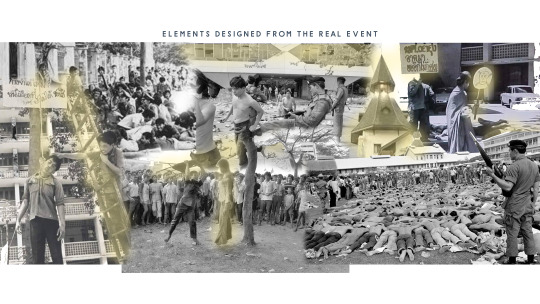
Fig 3.3. Inspiration of the Furniture Design
From that, the specific elements from each scene of the Thammasat Massacre are being use as inspiration for the furniture design for space.

Fig 3.4. Furniture Design
These pieces of furniture are modular and movable, so it could be used in the transformation of the space from the theatre space to the cafeteria, then the assembly space. The pieces are the Thammasat dome which is transforming into a prison, the assembling tables which is inspired from the building window, the Talipot fan which is used for poster exhibition, the ladder, the fences, the 14th Oct chair which is being during the Thammasat Massacre to hit the students with, the curtain which symbolized the hanged person, and the shoes which are enlarged to be the cemetery.
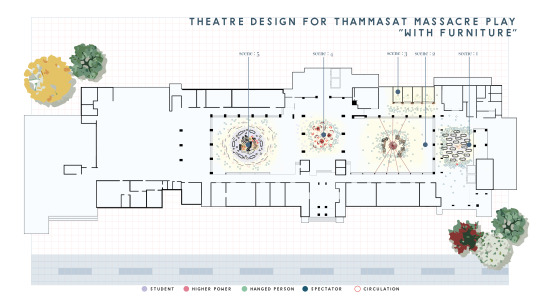
Fig 3.5. The Thammasat Massacre Play Design “with Furniture”
Afterwards, the design of the furniture layout is based on the base circulation of the play as you can see that it is separated into five scenes in sequence from right to left.

Fig 3.6. The Cafeteria Space Design
These spaces after being used as a part of the immersive theater play, the furniture are movable to transform into cafeteria space.The cafeteria spaces are for eating, reading, club space, group study, and a free space for a reassemble.
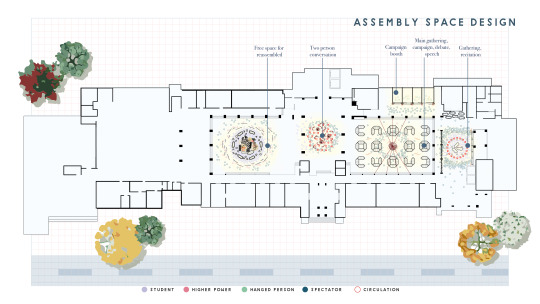
Fig 3.7. The Assembly Space Design
Also, the space is transformable into assembly space for a political gathering, talk, debate, speech, or campaign space based on any issue referring back to the quote that I stated earlier that the space of freedom does not fit into one.

Fig 3.8. SCENE I
For background information, the Thammasat massacre happened because the Thai press reported on a play staged by student protesters, on 6 October 1976, which allegedly featured the mock hanging of then Crown Prince Vajiralongkorn causing the attack by Thai state forces on student protesters on the campus of Thammasat University. But prior to the massacre, four to five thousand students from various universities had demonstrated for more than a week against the return of former military dictator Thanom Kittikachorn to Thailand from Singapore, so it is said that students were blamed unjustly by the press.
During SCENE 1, the monk is trying to receive alms from the dead students on the 6th October, while one student walks across the death to ask for permission to go to exam.
For scene one of the theatre design, I put the cemetery to symbolize the death students that were on the ground, and put the TalaPad fanto symbolize the Monk, and make the layout hard for the students to struggle to go past the area.
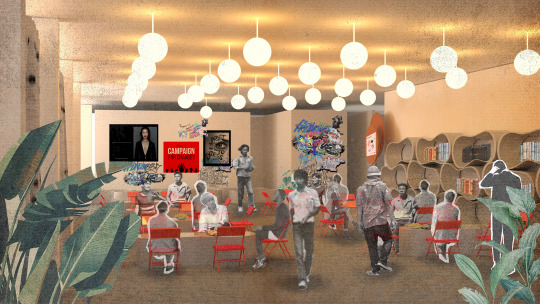
Fig 3.9. SCENE I, Cafeteria
For cafeteria space, this is an eating space which can be used for reading and club space.

Fig 3.10. SCENE I, Assembly
For assembly purpose, the space is used for gathering, recitation, and the exchange of ideas in large groups inspired from the circular plan

Fig 3.11. SCENE I, Plan
This is an architectural diagram of the space.

Fig 3.12. SCENE II
For SCENE 2, the main actor was hung down from the tree with the soldier to symbolize the the hanging of the Electric Authority in going against the monk.
So in the center, I designed the curtain installation that would symbolize the hung person where the furniture around symbolizing the people watching the event.
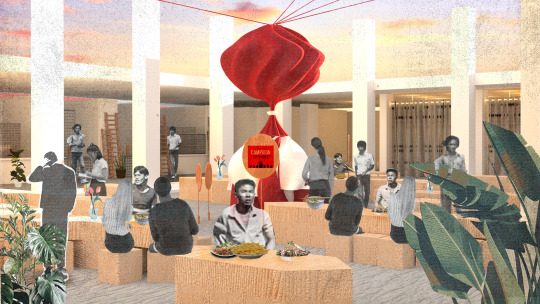
Fig 3.13. SCENE II, Cafeteria
For the cafeteria, it is transformable into the main cafeteria space and the table are movable up to the students' needs.
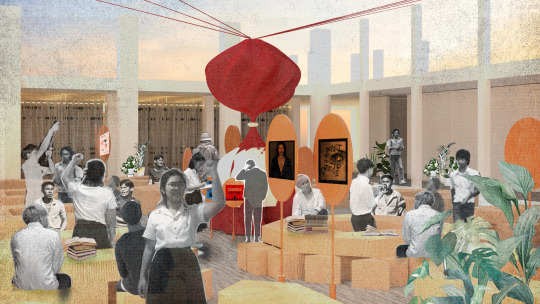
Fig 3.14. SCENE II, Assembly
The space is also used for campaigning purposes, debate speech, or a club space.
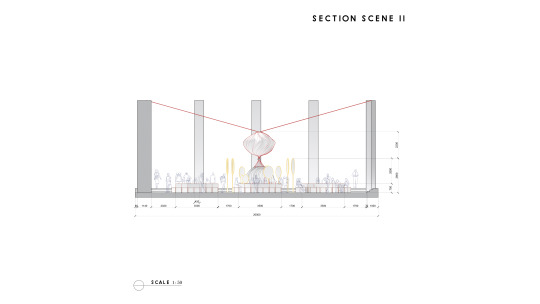
Fig 3.15. SCENE II, Section

Fig 3.16. SCENE II, Axon

Fig 3.17. SCENE III
For SCENE 3, the police deceive all the main actors and put them in jail without warning.
The fences that used to protect the shooter of the Thammasat Massacre were used as the design of the movable fences of the prison design in the theater play, and the ladder is symbolizing the higher power that are watching over the innocent students.
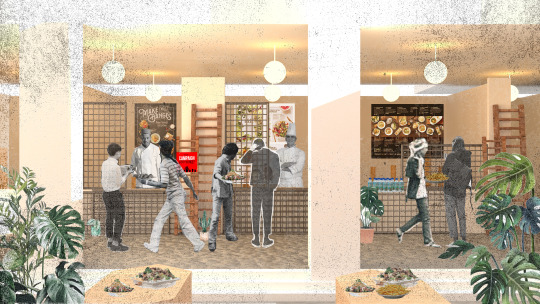
Fig 3.18. SCENE III, Cafeteria
For the cafeteria, the space is used as a food stall.

Fig 3.19. SCENE III, Assembly
The space is also transformable into the campaign booth area.

Fig 3.20. SCENE III, Section and Plan

Fig 3.21. SCENE IV
For SCENE 4, the higher power were taking the students outside to hang them on the tree and start hurting them while most student got arrested.
The chairs that were used for hitting the death students were laid all over the place and a curtain symbolised the innocent death.
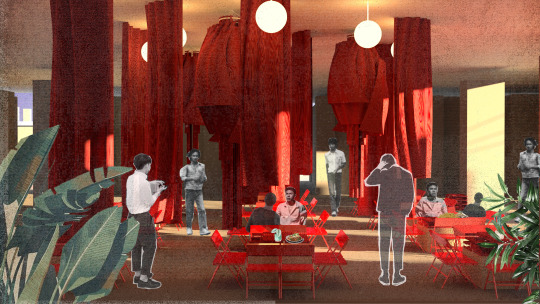
Fig 3.22. SCENE IV, Cafeteria
The space can also be used as an eating area and for studying in groups.
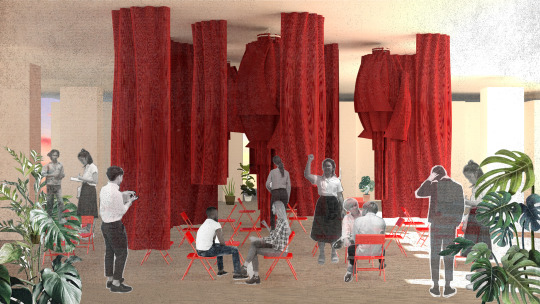
Fig 3.23. SCENE IV, Assembly
The assembly is for two person conversation which is influenced by the church confession box design where people are allowed to talk about anything without being judged on.

Fig 3.24. SCENE IV, Section and Plan
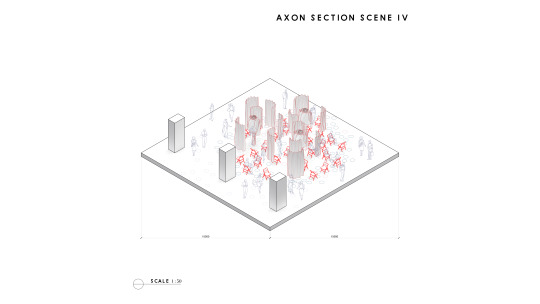
Fig 3.25. SCENE V, AXON

Fig 3.26. SCENE V
For SCENE 5, the uprising of the protest within the space were happening. Then the police forces were mass shooting from outside the fences of the University. Lastly, the space is lockdown, and everyone were laying on the ground with the soldier around them.
This is the last scene, and it is the most significant one because it is a space where the students were forced to surrender to the higher power, so this space is designed as a pile of wreck objects. The fences are symbolizing the higher power that is being protected behind these fences. This space is being planned for no alteration because it symbolises the ruins of democracy.
To summarise the design, these section of axon drawing of scene one to show clearly how the space is being transformed and reorganise for each of the purposes.
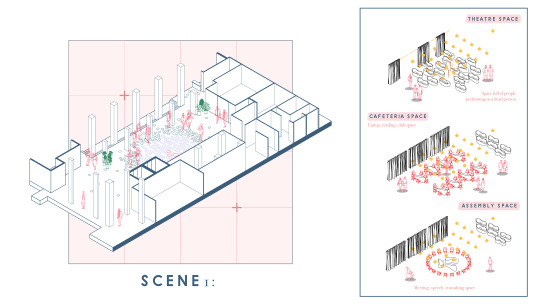
Fig 3.27. SCENE I, Diagram
For scene I, I emphasised on the table and the chair reorganisation of the space.
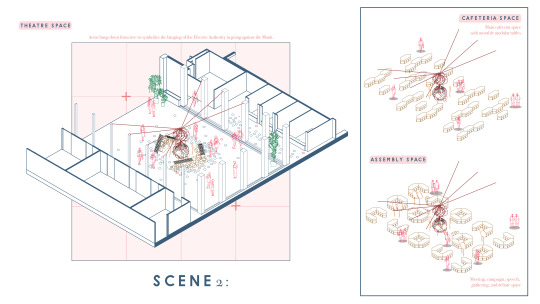
Fig 3.28. SCENE II, Diagram
For scene two, the space is being emphasized on the rearrangement of the table plan to achieve the goal of each space.

Fig 3.29. SCENE III, Diagram
Scene three is emphasized on the reorientation of the fences.
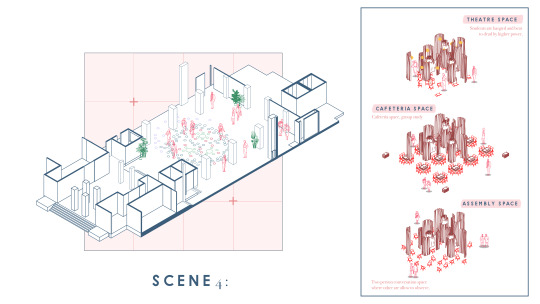
Fig 3.30. SCENE IV, Diagram
Scene four is emphasised on the reorganization after 14 October chair.
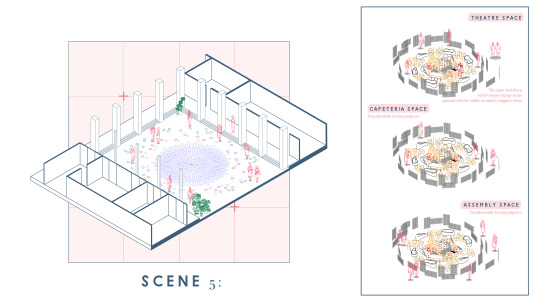
Fig 3.31. SCENE V, Diagram
The last scene is where I stated that it would stay the same throughout and can be adaptable and transformable according to the students' needs.
For the urban scale, I mapped out the significant universities relating to the government that this design could be placed to make a statement.
0 notes
Text
Information and Exchange
Besides, I've put together a documentary of site inspection of the ratchadamnoen area and conducted a few interviews of actual witnesses and also the normal civilians. With information and exchange as my main focus, I continue to research by going to different institutes and creating these periodic archive tables to categorize information according to its sources. I notice that information provided from each organization tends to reflect their political positions, it is biased and manipulative in a sense.

Truth is subjectivity Truthfulness of information is heavily rely on personal interpretation and whatkind of narrative it is being exchanged Everyone have their own interpretation of Truth, and so do I, This project is an investigation in finding my own definition of Truth.
Phase 1: Forensic Board Phase 2: Social experiment and Performative Phase 3: Manifesto and Design
Phase 1: Forensic Board

The 1st approach is to understand the structure of crowd through analysis of an historical event. Which I have chosen student uprising in 1973 and Thammasat Massacre in 1976
Then I created a forensic board which is a collection of evidence leading to analyze spatial and performative quality of crowds. In which I concluded that, information and exchange is one of the key factors that can control the direction of crowd, behaviour of crowd can likely be predicted based on what kind of information the majority receives.
--------------------------------------------------------------------------------------------
Phase 2: Social experiment and Performative
With information and exchange as my main focus, I continue to research by going to different institutes and creating these periodic archive tables to categorize information according to its sources. I notice that information provided from each organization tends to reflect their political positions, it is biased and manipulative in a sense.
Periodic Archive

Documentary: Interview
Besides, I've put together a documentary of site inspection of the ratchadamnoen area and conducted a few interviews of actual witnesses and also the normal civilians.
youtube
Performative
Parallel to information gathering, I conducted a social performative experiment to identify structure of information and exchange path. Which is made up of 3 actors sender, information and the receiver, left column is a classifying of 3 basic information type consisted of verbal, visual and physical
Social experiment: Information Layer
The 1st experiment is purely an experiment on information layer, by eliminating factors of having any involvement with another individual personality that might alter the outcome.
youtube
Social experiment: Urban Context
The 2nd experiment is by applying the same model onto an urban context
youtube
-----------------------------------------------------------------------------------------------
Phase 3: Manifesto and Design
Social experiment: Manipulative Layer of information
youtube
As mentioned in the 2nd phase about topic of manipulative An essential part in political linguistic, studying famous political figures and organizations like the NAZI and albert speer.
How they use emotive language and movement as a propagandistic tool in constructing a spatial representation to help enhance crowd control.
Forensic Timeline

I restaged the timeline of the protest, from the actual date of protest to the contemporary period. color presents different actors, the lines are the locations, the highlighted and dot lines represent moments of information exchange.
Documentary: Forensic Timeline
youtube
An illustration of the whole process towards my design proposal which is a ‘ Performative City Parade tour ‘ aimed for participants to experience the city through different interpretations of truth.
0 notes
Text
Top Ten Richest Lawyers
So, who are they? Here is a quick look at the wealthiest attorneys in the world, ranked from the lowest net worth to the greatest. Please be aware that the people on this list are practicing attorneys or judges. There are loads of additional "attorneys " using a considerably higher net value, but they simply have a law degree and no more use it.
Wichai Thongtang: $1.1 billion
Thought of by many in the industry to become "one of the top titles in the profession from across the planet," Wichai Thongtang is a strong lawyer in Thailand. After graduating from Thammasat University in 1970, he went into corporate law, by which he represented a range of leading Thai executives and businesses and took the opportunity to learn about the stock market and investing. Besides his law profession, Thongtang is the Chairman of Cable Thai Holding PLC and owns 15 percent of Dusit Medical, a Bangkok healthcare company.
Lynn Toler: $15 million
Better called the judge from TV's Divorce Court since 2007, Lynn Toler previously served as the only municipal court judge from Cleveland Heights, OH for at least 8 years. After receiving her law degree from the University of Pennsylvania Law School in 1984, she focused on civil law before getting municipal court judge. In this function, she was known for enforcing nontraditional sentences, such as writing essays. In addition to presiding over divorce court, Lynn is the author of 3 books.
Jane Wanjiru Michuki: $60 million
Educated at the Kenya School of Law and Warwick University, Jane Wanjiru Michuki is currently a managing partner at Kimani & Michuki Advocate, a corporate law firm in Nairobi, Kenya that represents Many of the biggest corporations in Kenya, such as Equity Group Holdings Limited. In addition to her law career, she is the biggest female stockholder on the Nairobi Stock Exchange, which is where a good piece of her net worth stems from.
Mark Geragos: $25 million
A 1992 graduate of Loyola Law School, Mark Geragos is a criminal defense lawyer who has also been engaged in a number of landmark civil litigation class action instances. He has represented everyone from Chris Brown, Michael Jackson, and Winona Ryder to Scott Peterson and Susan McDougal. Named "One of the 100 Most Influential Lawyers in California," he holds a record for one of the top 10 verdicts in California history to get a 2008 case in which he acquired a jury verdict awarding more than $38 from a pharmaceutical company. He currently serves as a managing partner at Geragos and Geragos.
0 notes
Text
Top 10 Lawyers In Usa
So, who are they? Here's a quick look in the richest attorneys in the entire world, ranked from the lowest net value to the greatest. Please note that the individuals on this list are all practicing lawyers or judges. There are plenty of other "lawyers" with a substantially higher net value, but they simply have a law degree and no longer use it, more ideas to https://gklaw.ca/.
Wichai Thongtang: $1.1 billion
Thought of by many in the sector to become "one of the top titles in the profession from across the globe," Wichai Thongtang is a strong lawyer in Thailand. After graduating from Thammasat University in 1970, he moved into corporate law, by which he represented a number of top Thai executives and businesses and took the chance to learn about the stock exchange and investing. Besides his law profession, Thongtang is the Chairman of Cable Thai Holding PLC and owns 15 percent of Dusit Medical, a Bangkok healthcare firm.
David Boies: $20 million
Currently serving as the chairman of Boies, Schiller & Flexner, David Boies formerly served as Chief Counsel for the US Senate. He graduated from Yale University in 1966 and almost immediately made a name for himself. He amassed his fortune by representing several large corporations, such as IBM, Napster, George Steinbrenner (proprietor of the NY Yankees), CBS, and the NBA Players Association during the 2011 NBA lockout. According to Fortune magazine, he's "corporate America's number-one hired gun. "
Willie E. Gary: $100 million
Nicknamed "The Giant Killer," Willie Gary has taken on several of the country 's most important corporations, including Anheuser-Busch and Disney. He has won a number of the largest settlements and jury awards at the U.S., including many cases valued at more than $30 billion. A graduate of Shaw University, he's now the managing partner at Gary, Williams, Parenti, Watson, and Gary, P.L.L.C., works as a motivational speaker, and has appeared as a legal analyst on "The Early Show. "
Robert Shapiro: $50 million
Presently a senior partner at Glaser, Weil, Fink, Jacobs, Howard, Avchen, and Shapiro, LLP, Robert Shapiro graduated from Loyola Law School in 1968 and started a career as a criminal lawyer. After serving on O.J. Simpson's legal team (and representing several other celebrities), he chose to move into civil litigation. Besides his law career, he's written a children's publication and is a co-founder of LegalZoom and Shoedazzle.com, click to https://canadianimmigrationexperts.ca/.
Judge Joe Brown: $30 million
Best known for his daytime court series which ran for 15 decades, Judge Joe Brown received his law degree from UCLA. After working as the first African American prosecutor in Memphis, TN, he started his own clinic prior to working as a criminal court judge in Shelby County, TN. While presiding over James Earl Ray's appeal for its assassination of Martin Luther King, Jr., he caught the attention of TV producers. The majority of his wealth was gained via the show. In 2014, he ran for district attorney general in Shelby County, but lost to the incumbent.
William Lerach: $900 million
Although he was disbarred in 2009 because of his participation in a kickback scheme, William Lerach had a rewarding career as a corporate lawyer with a specialty in private securities class actions suits for more than 30 decades, which is how he gathered his considerable fortune. Nicknamed the "King of Pain" and often known as the most feared lawyer in American during his heyday, Lerach, a University of Pittsburg School of Law graduate, holds the record for the largest sum ever recovered in a group of securities class actions lawsuits for the $7.12 billion judgement he obtained against Enron, more ideas to https://immigrationlegalcanada.com/.
0 notes
Text
Thailand targets 2023 for the BULLET TRAIN
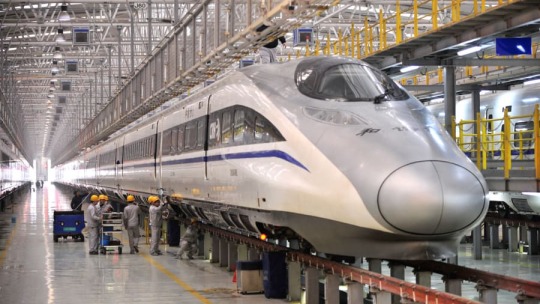
After years of delays and much debate, it's finally happening. #Bullettrains are coming to #Thailand.
With one project under construction, another approved and others being considered, many in the country are questioning whether high-speed rail (HSR) will be the right fit for the country. "This is going to be a big change for Thailand," says Thanet Sorat, an adviser to Thailand's Senate Committee on Transportation, vice president of shipping company, V-Serve, and president of the Thai Authorized Customs Brokers Association. He hopes to see sleek trains pinballing around the country at 155 mph (250 kph) within five years. Both projects currently in the works will employ Chinese HSR technology. Though Thailand declined Chinese loans, the projects are considered a part of the Belt and Road Initiative (BRI), a plan that aims to connect China to the rest of Asia through new transport infrastructure. Bangkok to Pattaya in 45 minutes Expected to open in 2021 to replace Bangkok's 103-year-old Hualamphong Station, a massive new rail hub in the city's Bang Sue district will serve passengers using both HSR and the country's existing railway network, which is being upgraded from single to dual track. Tied to this, on October 24, a conglomerate led by Thailand's CP Group signed a contract with the State Railway of Thailand (SRT) for the construction of a HSR line linking Bangkok's two airports, Suvarnabhumi and Don Mueang, to three eastern provinces. It will operate in addition to the existing Airport Rail Link, an elevated train that connects Suvarnabhumi to Bangkok's metro system. The planned line, beginning from Don Mueang then passing through Bang Sue, will also stop at Makkasan in central Bangkok before proceeding to Chachoengsao, Chonburi, Sriracha and Pattaya, a major tourist destination located 75 miles (120 km) south of Bangkok on the Gulf of Thailand. Expected to begin service in 2024, the 137-mile line will terminate at U-Tapao Airport, outside of Pattaya in Rayong province.
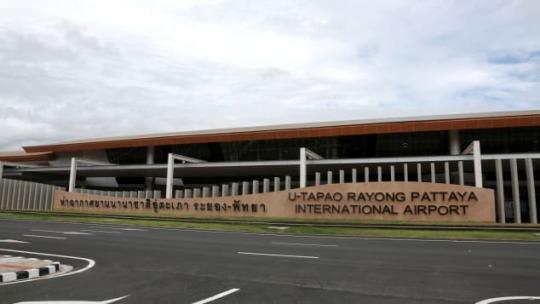
The new line will connect Bangkok's two airports with U-Tapao Airport in Rayong province, an industrial and fishing hub.- Pailin Wedel/Bloomberg/Getty Images The government plans to move some 10% of flights from Bangkok to a redesigned U-Tapao in order to ease congestion at Suvarnabhumi and Don Mueang. "To do that, they need a transportation link between the airports, and it could be a good opportunity for HSR," says Jittichai Rudjanakanoknad of Chulalongkorn University's Department of Civil Engineering. A conglomerate led by Thailand's Charoen Pokphand Group (CP), which also includes the China Railway Construction Corp., will cover an investment of 224 billion baht ($7.4 billion) in exchange for real estate concessions and a 50-year license to operate the line. One goal is to provide easy access to the Eastern Economic Corridor (EEC), a zone that Thanet says constitutes 80% of total foreign investment in Thailand.
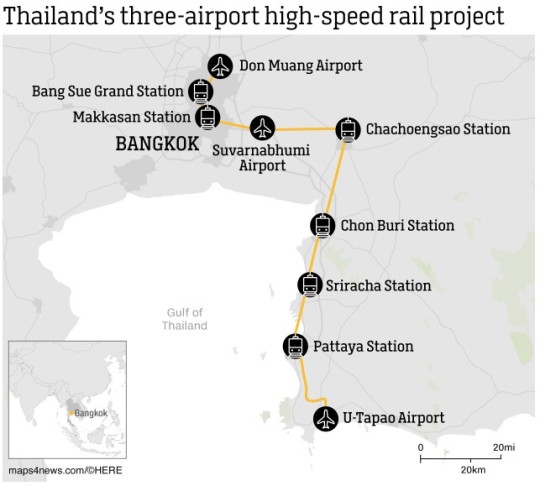
Supporters point out that HSR will reduce travel time between Bangkok's two airports to just 20 minutes, and shuttle tourists to Pattaya in less than an hour. They also predict it will reduce traffic on highways, curtailing accidents in a country with one of the world's highest road fatality rates. As it stands, transferring between Suvarnabhumi and Don Mueang entails a shuttle bus journey that can last an hour or more during Bangkok's notoriously sluggish rush hours. Reaching Pattaya from Suvarnabhumi requires haggling with a taxi driver, taking a cramped van or traveling across town to catch a bus from Ekkamai Terminal for the two-hour ride. "Linking the three airports is a noble objective," says Ruth Banomyong, director of the Center for Logistics Research at Bangkok's Thammasat University. But he and other critics question whether HSR is the right choice, given the high cost and relatively short distances involved. Some argue that dual-track rail would suffice for the eastern provinces, which currently lack any railway at all. The SRT said in September that 80% of land needed for the three-airport line has been secured for expropriation, and the Bangkok Post has reported that 3,000 houses will need to be demolished. Adding that gas and electrical lines may also be affected, Jittichai says, "it's not easy to relocate people. Some are going to court and it takes quite a long time." Bangkok to Khorat in 77 minutes

Construction of the China-Laos railway is now underway in Yunnan province. - Ren Dong/China News Service/Visual China Group/Getty Images Expected to open in 2023, Thailand's maiden HSR line is now under construction beside existing railway tracks in Nakhon Ratchasima, a northeastern province also known as Khorat. Unlike on the three-airport line, Chinese state firms are responsible for nearly all of the construction. Beginning at Bang Sue, this 157-mile "Khorat line" will stop at Don Mueang Airport and the historic capital of Ayutthaya before cutting northeast to Saraburi and Pak Chong near the popular Khao Yai National Park. It will terminate at Khorat -- at least until the track is extended. The government's long-term plan is to extend the line north to Nong Khai, located 370 miles (600 km) northeast of Bangkok and home to a popular border crossing that enables travelers to reach the Lao capital of Vientiane. After crossing the Mekong River on a new bridge, passengers would be able to continue north on another HSR line now being built in Laos. The ultimate goal is to link these lines with Kunming in southern China's Yunnan province. The Khorat line has drawn more criticism than the three-airport line due to the investment of 179 billion baht ($5.9 billion) worth of public funds. Critics argue that northeast Thailand is not on the agenda for most tourists, while also expressing frustration about a lack of transparency when Thailand's military government approved the project in 2017. In a report first published by The Diplomat, Pechnipa Dominique Lam of the Thailand Development Research Institute estimated the line "would need to ferry 50,000-85,000 passengers every day for 20 years in order to pay back the costs of investment." At only 5,000-25,000 riders per day, the Transport Ministry's own forecasts fall well short of those numbers.
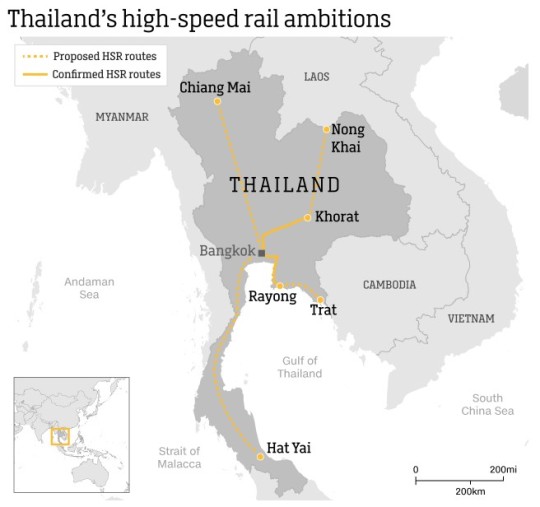
"Taking into account the benefits arising from the HSR, such as passengers' time savings on travel," she went on, "the economic case in favor of doing the project is still outweighed by its financial losses." "This line is mostly influenced by China," adds Jittichai. "If Thailand builds it, we might not get much benefit. But if we don't build it, we could lose other benefits from China. That is what the government is thinking." Competitive transport market
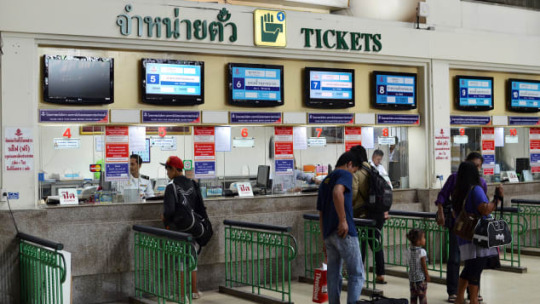
Both the SRT and the state-run bus service have long been operating at a deficit. - David Luekens "There is a strong risk that HSR might not be successful because of existing transport connectivity," according to Ruth. Both the SRT and the state-run bus service have long operated at financial losses as passenger numbers decline each year. The state-run airline, THAI, is also struggling as budget carriers like Air Asia and Nok Air compete with fares from Bangkok to more than 20 other Thai cities for as little as $20. Critics also wonder if enough Thai people can afford HSR in a country with a notably wide economic divide and a minimum wage of only 300 baht ($10) per day. Although most middle-class Thais can manage the proposed 330 baht fare for a bullet train from Bangkok to U-Tapao, and 500 baht to Khorat, many of them are attached to their private automobiles. As for the working class, they may end up sticking to buses and vans that cost roughly a quarter of the proposed ticket prices for HSR. Regular trains are even cheaper and the coming dual tracks will shorten travel times on existing railway lines, adding another layer of competition. While waiting for a train at Khorat's 119-year-old railway station, Daeng Tungsunern, a Khorat native who sells second-hand goods, tells CNN, "I did not know about the HSR project until it was already being built. I will not use it because it will be too expensive for my budget." "Just like in Japan"
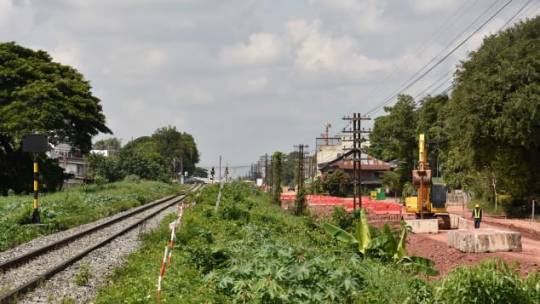
HSR track construction is now taking place beside the existing single rail track in Noen Sung district, Nakhon Ratchasima province. - David Luekens In the future, Thanet envisions Thailand as a central hub in a Southeast Asia linked by bullet trains. He also sees value in the transfer of technology, suggesting that "20 years into the future, we should be able to produce high-speed trains ourselves and not only buy them from China or Japan." Jittichai agrees HSR could become worthwhile "if looking at a broader network, for example, if the Thai lines can be connected to the Chinese network or Singapore, or even to central Asia and Europe." To that end, the government is considering additional HSR lines running north from Bangkok to Nakhon Sawan, Phitsanulok and Chiang Mai; south through Hua Hin, Surat Thani and Hat Yai; and further east from Rayong to Chanthaburi and Trat near Cambodia. Subsequent projects might extend the proposed southern line through Malaysia to Singapore, while a northern line could link with a western extension to Myanmar and onwards to India. The SRT is already promoting these additional projects, but the extremely high price tags are likely to prohibit them from taking shape any time soon. "If the cost of construction and technology becomes cheaper, that is when you will see these other lines," says Jittichai. Back inside Khorat's railway station, Paitoon Tikul, a retired soldier who rides trains and his bicycle around Thailand to raise money for charity, says, "I think HSR will be useful for certain people. But the cost of these projects is very expensive, and I worry about corruption. In my opinion, it would be better to use that money for improving schools, hospitals and more useful things." As a roughly 50-year-old train clinks into the station, railway police captain Nutthawoot Sawanphomrat interjects, saying "I think HSR will be good for the country and the economy. Just like in Japan." – You can follow BangkokJack on Instagram, Twitter & Reddit. Or join the free mailing list (top right) Please help us continue to bring the REAL NEWS - PayPal Read the full article
0 notes
Text
Nan----Provinsi Paling Utara, Penuh Cerita
I’ve been here for 2 weeks. It feels like I came just yesterday. When the first day I came to this place, I can’t understand what are they talking, what are they want. Now, I am trying to understand, studying thai language, making some gesture, playing games. I know that they want and try to talk to me, but I just can’t understand. They just hugged me and said “teacher anggun” with a big smile.
Yhu Wittaya School
Sekolah non-government di kota Muang Nan, Nan, provinsi paling utara Thailand. Jauh dari Bangkok, ya sekitar 11jam menggunakan bus dari Bangkok untuk sampai ke kota ini. Biarpun terletak di kota kecil, sekolah ini penuh dengan hal-hal yang membuat saya terkagum-kagum
Sawadee Teacher, Good Morning, Good Afternoon.
Ya, mereka selalu menyapa. Selalu. Setiap saya menyusuri sekolah ini, tak henti-henti mendapat senyuman dan sapaan dari mereka. Mereka ramah, sangat ramah. Mulai dari kepala sekolah, guru, dan murid-muridnya.
Take a nap
Kindergarten students are taking a nap at 11 am-11pm. Murid-murid sendirilah yang menata tempat tidur mereka sebelum tidur dan setelah bangun mereka akan menata kembali tempat tidur mereka ke tempat semua. Sangat terorganisir dan sudah jadi kebiasaan baik bagi anak TK untuk menata dan merapikan sebuah barang.
Make a line and take off your shoes!
Sudah jadi kebiasaan bagi mereka membuat barisan saat akan pergi mengikuti gurunya. Ya, sangat lucu. Mereka membuat barisan laki-laki dan perempuan secara terpisah. Lalu mereka melepaskan sepatu sebelum masuk ruangan. Dan kerennya, selalu rapi. Sepatu mereka tertata dan berjejer rapi di depan kelas maupun ruang belajar layaknya sebuah barisan.
Happy Mother’s Day, Mommy!
Tanggal 12 Agustus, ulang tahun ratu Thailand sekaligus ditetapkan sebagai hari ibu di Thailand. Semua murid disini membuat sebuah ucapan dengan tulisannya masing-masing untuk ibu mereka. It was awesome!
Susu Gratis
Mereka mendapat 1 kotak susu setiap harinya. Setiap murid mengambil susu di sebuah kotak kardus di kelasnya. Antri mengambil satu-satu dan tanpa berebutan.
Lunch Together
Makan siang bersama di kantin sekolah dan makanannya? Sekolah lah yang menyediakan. Masing-masing dari mereka punya perlengkapan makan sendiri. Oiya, mereka selalu menyikat gigi juga sesudah selesai makan menggunakan pasta gigi dan sikat gigi masing-masing.
About Nan Province dan People
Mereka semua sangat baik. Sangat. Setiap orang disana selalu gives her big smile. Ya! Bahkan walaupun kita belum pernah bertemu maupun kenal sekalipun. Dan “Sawasdee krap/kha” selalu menjadi salam khas disetiap sapaannya.
Kota ini bukan kota besar layaknya Bangkok atau Chiang Mai. Kecil, setiap jam 8 malem udah sepi, jarang ada kehidupan, department store dan restoran mulai tutup, hanya ada beberapa tenda makan pinggir jalan dan seven eleven yang buka. Harga barang disini murah-murah, kata orang thai sendiri memang daerah utara Thailand terkenal akan kemurahannya.
Sawah-sawah di beberapa tempat menjadi obat rindu pada Indonesia. Tempat wisata disini? Jangan salah, biarpun terletak di utara Thailand, daerah ini terkenal akan banyaknya national park dan waterfall, ada national museum terkenal pula di daerah ini. Bahkan saya, mendapat sebuah map dari tourist center yang isinya wisata-wisata di Nan. Doi Phuka National Park, salah satu national park yang saya kunjungi. Tempatnya indah, benar-benar alami dan udaranya sangat segar.
Walaupun menjadi kaum minoritas, saya senang berada disini. Mulai dari kotanya, sekolahnya, dan orang-orang yang membuat saya selalu nyaman. And yes! As you teach, you learn. A lot of experience I got here. I will try to apply good experience that I got here to my beloved country, Indonesia. There are still 4 weeks more and I won’t to waste my time here.
Anggun Pulihana Wilujeng
Exchange Participant Sawasdee30 Project AIESEC
Local Committee Thammasat
Nan, 5 Agustus 2018 01:48 AM
0 notes
Text
Top Ten Richest Lawyers In America
So, who are they? Here's a fast look at the richest lawyers in the world, ranked from the lowest net worth to the highest. Please be aware that the individuals on this list are practicing lawyers or judges. There are loads of other "attorneys " with a substantially higher net worth, but they simply have a law degree and no more use it.
Thomas Mesereau: $25 million
Additionally a criminal defense lawyer (Are you noticing a trend?) , Thomas Mesereau graduated from Harvard University and The University of California's Hastings College of Law and has been appointed "Trial Lawyer of the Year for 2015" from the National Trial Lawyers. (He has won lots of other awards including "Criminal Defense Lawyer of the Year. ") He's known for carrying high stakes instances with impossible odds and getting extraordinary results. He had been Michael Jackson's lawyer when he was acquitted of 14 child molestation charges and has won an unprecedented three national criminal jury trials in a row. While his hourly rate is so high it's not published, he also does pro bono work through the Mesereau Free Legal Clinic.
Wichai Thongtang: $1.1 billion
Considered by many in the industry to be "one of the top names in the profession from around the globe," Wichai Thongtang is a strong lawyer in Thailand. After graduating from Thammasat University in 1970he moved to corporate law, where he represented a range of top Thai executives and businesses and took the opportunity to learn about the stock exchange and investing. In addition to his law career, Thongtang is the Chairman of Cable Thai Holding PLC and owns 15 percent of Dusit Medical, a Bangkok healthcare firm.
Richard Scruggs: $1.7 billion
A 1976 graduate of the University of Mississippi School of Law and also a prominent trial attorney, Richard Scruggs is famous for his love of tobacco and asbestos cases and the fact that he won more than $1 billion in judgements against various companies. He was also highly involved in 2000's Ritalin class action suits, as well as the 2003 situation against Lehman Brothers for which he won a $51 million verdict. But in 2007, he was accused of judicial bribery. In 2008, he pled guilty and eventually served six years in prison. Now, in the age of 70, he's completed his sentence, and it has kept his massive fortune.
David Boies: $20 million
Currently serving as the chairman of Boies, Schiller & Flexner, David Boies previously served as Chief Counsel for the US Senate. He graduated from Yale University in 1966 and almost immediately made a name for himself. He gathered his fortune by representing several large corporations, including IBM, Napster, George Steinbrenner (owner of the NY Yankees), CBS, and the NBA Players Association throughout the 2011 NBA lockout. According to Fortune magazine, he's "corporate America's number-one hired gun. "
0 notes
Text
A Dozen of the Richest Practicing Lawyers in the World
I thought it might be interesting and fun to take a look at the richest lawyers in the world. These lawyers put the top of the biglaw salaries to shame. We’re talking about people with at least an eight digit net worth. How did they become so rich?
Many of these familiar faces, like Judge Judy or legal and political analyst Alan Dershowitz, make regular television appearances and offer routine commentary. These individuals have tried cases of all kinds—from the massive and mundane to the captivating and bizarre. Over lengthy careers, they’ve amassed significant wealth and continue to dominate their respective fields as exceptionally hard-working, pioneering people.
Without further ado, here’s the current list of the top 12 wealthiest, practicing lawyers:
1. Wichai Thongtang
Net Worth: $1.8 billion
Wichai Thongtang is a powerful corporate billionaire lawyer in Bangkok Thailand who successfully represented former Thai Prime Minister Thaksin Shinawatra in an asset concealment case back in 2001. That case instantly catapulted this humble farm boy celebrity status throughout Thailand and abroad.
Thongtang graduated from Thammasat University and began practicing corporate law in the 1970s, representing leading Thai executives and their companies. Though he is still chairman of his eponymous international law firm, much of Thongtang’s wealth comes from strategic investment holdings that he has acquired throughout his career, including several hospital-related holdings and a Thai cable company.
Yes, you read that right. He got rich by being a capitalist through investments made by his lawyer earnings.
2. Charlie Munger
Net Worth: $1.6 billion
Charlie Munger might be better known as Warren Buffett’s partner at Berkshire Hathaway but he is a Harvard educated lawyer with a serious bankroll. Most of his net worth is tied up in Berkshire Hathaway but he is also the founding partner of Munger, Tolles & Olson LLP, a law firm he started in 1962.
Eventually Munger gave up the practice of law when he realized he could make significantly more money contracting on managing his investments and working with Warren Buffett (how’s that for a good financial decision – quit the law firm that you started in 1962 and open up a partnership with Warren Buffett). I bet his peers thought he was crazy at the time.
He’s got a lot of good quotes but one of my favorite is:
To get what you want, you have to deserve what you want. The world is not yet a crazy enough place to reward a whole bunch of undeserving people.
3. Bill Neukom
Net Worth: $850 million
Bill Neukom, a Stanford Law School graduate, served as the lead lawyer for Microsoft Corporation for almost 25 years, skillfully guiding the company through treacherous anti-trust and intellectual property litigation. His high-profile cases include the “trial of the century,” otherwise known as United States v. Microsoft.
At Microsoft, he was responsible for managing legal and governmental affairs as well as its active philanthropic activities, retiring as the Vice President of Law and Corporate Affairs. Neukom was eventually selected to serve as the president of the American Bar Association from 2007-2008.
Neukom went on to become the CEO of the San Francisco Giant baseball team between 2008 to 2011, guiding the team to its first World Series win since moving to California in 1958. He now works as primarily as the founder, president, and CEO of the World Justice Project. His foundation is focused on strengthening the rule of law to promote the development of communities of opportunity and equity around the world.
4. Judge Judy
Net Worth: $440 million
Judge Judith Sheindlin, television’s beloved “Judge Judy,” has come a long way from her days as a family court judge. She raked in a cooll $47 million for the latest season of her small-claims court show. Her outspoken persona has made her one of the highest-paid women on daytime television.
Although Sheindlin’s actual net worth is unknown, Forbes estimates that she deserves a place on the list of the richest self-made women in America and named her the world’s highest-paid TV host in 2018. Judge Judy has a penchant for real estate, tying up at least some of her fortune in several expensive homes around the country. She also decided to pass up commercial air travel after 9/11. Instead, she uses her own private jet to commute from the set of Judge Judy in Los Angeles from her home in Florida.
5. Robert Shapiro
Net Worth: $120 million
Robert Shapiro is a practicing lawyer who gained notoriety for being on the team responsible for exonerating O.J. Simpson from the murders of Simpson’s ex-wife and Ron Goldman. He has represented clients from Johnny Carson to Occidental Petroleum and Rockstar Energy Drinks.
Though he amassed most of his wealth from his legal career, Shapiro is also an effective entrepreneur. He is a founding member of LegalZoom, Shoedazzle.com, and Right Counsel. In addition, Shapiro has also starred as himself and as a lawyer on both television and the big screen. He earned the best film award from the Tenerife International Film Festival in 2015.
The 2005 death of his son due to a drug overdose inspired Shapiro to write the children’s book Somo Says No, which contains an anti-drug message. Along with his family, he founded the Brent Shapiro Foundation and Pickford Lofts to assist and rehabilitate drug addicts.
6. Willie E. Gary
Net Worth: $100 million
Willie E. Gary, named one of the “top 50 US attorneys” by Forbe, and one of the “100 most influential African-Americans” by Ebony magazine, is a trailblazing lawyer and entrepreneur from Georgia who went to law school in North Carolina. He is one of the founding partners of the first black law firm in Martin County, Florida, where he continues to practice.
Gary has led several high-profile litigations against large corporations, including a $500 million-dollar settlement to an undisclosed client from Mississippi, that have earned him significant wealth and prestige. He has been interviewed on the Oprah Winfrey Show and other talk shows. Despite some recent legal troubles of his own, Gary is a renowned philanthropist. Along with his wife, Gloria, he funds college scholarships for at-risk students through the Gary Foundation. He has also donated substantial sums to his alma mater and other black universities in the US.
7. John Branca
Net Worth: $100 million
John Branca, born in Bronxville, New York, is one of the richest lawyers practicing entertainment law today. He moved to Los Angeles at age 11 and has lived there since. Branca received his law degree from UCLA law school in 1975 and is responsible for pioneering many entertainment-focused ventures.
An avid musician, he specializes in representing rock and roll acts and independent music labels. Over 30 of his clients, including The Rolling Stones, Aerosmith, ZZ Top, Fleetwood Mac, and The Doors, are in the Rock and Roll Hall of Fame—more than any other entertainment lawyer.
Branca is responsible for much of the success of Michael Jackson’s Thriller music video. He sought financing for the project and his production influence led to millions of sales of that album. He also advised and facilitated Michal Jackson’s purchase of ATV Music publishing—a move that made the Jackson family hundreds of millions of dollars while they owned it. After fighting Michael’s mother over the absence of a will after his death, he continues to manage Jackson’s estate. Branca is credited with restoring and reviving Michael Jackson’s legacy through several lucrative posthumous films, shows, and experiences.
8. Roy Black
Net Worth: $65 million
Roy Black is a civil and criminal defense trial attorney based in Miami. He defended William Kennedy Smith against rape charges in 1991 and has also represented other big names like Rush Limbaugh, Kelsey Grammer, Jeffrey Epstein, and Justin Bieber.
He is famous for brilliantly-delivered, well-studied arguments during trial, and he received the highest possible score on the Florida Bar exam when he took it in 1970. Black is often referred to as “The Professor,” possibly alluding to time that he spent teaching as an adjunct professor in criminal evidence at the University of Miami.
Black frequently appeared on Good Morning America and the Early Show as a legal consultant. He has also appeared on The Real Housewives of Miami as his third wife, Lea Black, is one of the castmates. Black began dating Lea a few months after she served as a juror in Black’s case for William Kennedy Smith.
9. Jane Wanjiru Michuki
Net Worth: $60 million
Jane Michuki is a Kenyan lawyer, investor and businesswoman who graduated from the University of Warwick in the U.K. She is the managing partner of Kimani & Michuki Advocates. Her firm currently represents an extensive list of clients including Equity Group Holdings, Ltd., which is the largest bank holding company in Africa, serving over 9.2 million customers. Michuki served lead counsel for several massive housing project developers in Kenya, including the Suraya group.
In addition to practicing law, she is the largest female stockholder on the Nairobi Stock Exchange. Michuki is also a recognized humanitarian, serving as both a Human Rights consultant with the United Nations and the Special Representative to the Secretary General to the United Nations Mission Liberia.
10. Alan Dershowitz
Net Worth: $25 million
Dershowitz is a distinguished attorney and respected Harvard Law School professor. He was born in New York, leaving to obtain his law degree at Yale University.
Dershowitz was the youngest full professor of law at Harvard by 28 years of age, serving until his retirement in 2013. Since then, he has continued to work within his expertise of constitutional and criminal law as a frequent political commentator, legal analyst, and media contributor. He defended Supreme Court Nominee Brett Kavanaugh against allegations of rape leveled by Julie Swetnick prior to Kavanaugh’s confirmation.
Dershowitz recently cemented his legacy as a household name during Donald j. Trump’s recent impeachment trial. He initially joined Trump’s defense team, even offering to work for free in an effort to hold up a pure, scholarly defense of the continuation. In fact, Dershowitz published an entire book in 2018, The Case Against Impeaching Trump, to defend his position. As additional evidence surfaced, he clarified his previous statements, reversing his position and ultimately publicly calling for Trump’s impeachment.
11. Mark Geragos
Net Worth: $25 million
Geragos is an Armenian-American criminal defense and civil litigation lawyer based in Los Angeles. He was one of the lawyers in charge of a class-action suit against New York Life Insurance and AXA, securing sizeable settlements on behalf of Armenians who were issued insurance policies during the time of the Armenian genocide.
His first landmark case, however, was representing Susan McDougal of Whitewater notoriety. He has also defendedScott Peterson (later sentenced to death for the murder of his wife, Lacey), Chris Brown, Kesha, and, more recently, Colin Kaepernick and Jussie Smollett. Geragos briefly represented Michael Jackson in his molestation case but was replaced due to a very hectic schedule.
Geragos frequently appeared on CNN and Larry King Live as a legal consultant before being removed in 2019, pending his implicated involvement in an extortion scheme with Michael Avenatti. He’s also been featured on Good Morning America, 60 minutes, and Anderson Cooper 360.
12. Thomas Mesereau
Net Worth: $25 million
Thomas Meseareau, a Harvard and UC Hasting’s College of Law grad, is a criminal defense attorney. After Geragos was taken off Michael Jackson’s molestation case, Mesereau stepped in and famously had him acquitted of all charges. He’s also represented celebrities Bill Cosby and Mike Tyson at one point.
Mesereau is one of the top trial lawyers in America, having won an unheard-of three federal criminal jury trials in succession. If that’s not enough, he has a reputation for taking on high-stakes cases with impossible odds, too.
His hourly rate is so high that it isn’t published, but Mesereau does take on pro bono cases through the Mesereau Free Legal Clinic that he established. Every year, he represents a capital murder defendant from the south who can’t afford representation.
Bonus: Judge Lynn Toler
Net Worth: $15 million
Judge Lynn Toler is best known for the thirteen years that she spent on her television show, Divorce Court. Before she was a celebrity, Toler served as the only municipal judge in the Cleveland Heights Municipal Court in Ohio, winning her first judicial race by only 6 votes since she ran as a Republican in a Democratic district. Judge Toler is known for her level-headed, common-sense approach to the cases that she hears as well as non-traditional judgments, like hand-written essays.
In 2008, she hosted the show Decision House, and served as co-executive producer of Wedlock or Deadlock, a Divorce Court spinoff. She continues to contribute to her community, receiving the Humanitarian of the Year Award from the Cleveland Domestic Violence Center, and serving on the boards of charities like the Juvenile Diabetes Board and the National Alliance for the Mentally Ill.
Our list only contains living attorneys, so we did not include the estate of Joe Jamail who was estimated to have a net worth of $1.5 billion (known as the “King of Torts”) and responsible representing Pennzoil in a landmark lawsuit against Texaco where he reportedly netted $355 million on a contingency fee
Originally posted on A Dozen of the Richest Practicing Lawyers in the World
Biglaw Investor - Personal finances for the aspiring millionaire lawyer
A Dozen of the Richest Practicing Lawyers in the World published first on https://immigrationlawyerto.tumblr.com/
0 notes